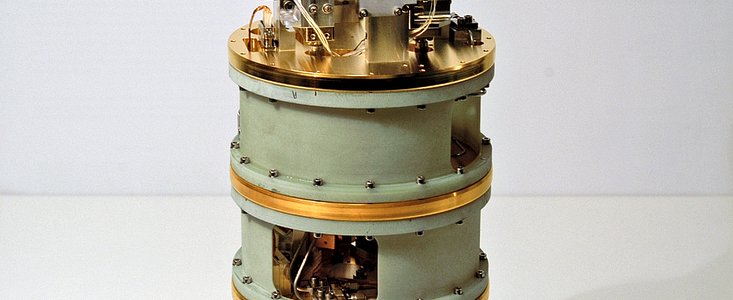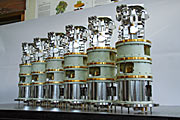Annuncio
First Complete Set of Detectors for ALMA Delivered to ESO
All ALMA Band 9 receivers provided by NOVA
21 Dicembre 2011
The European Southern Observatory (ESO) has just taken delivery of the last of a set of 73 state-of-the-art extremely sensitive detectors for the Atacama Large Millimeter/submillimeter Array (ALMA) project, from NOVA (the Netherlands Research School for Astronomy).
When complete, ALMA will consist of 66 large antennas, operating as a single telescope. It will observe the Universe in light with wavelengths around one millimetre or less — very short wavelength radio waves. To do this, each of the antennas must be equipped with an arsenal of detectors, like highly sensitive radio receivers, operating in different wavelength bands. The receivers, which are being made by institutes in Europe, North America, and Japan, must be cooled to temperatures of -269 degrees Celsius in order to detect the faint signals from space.
The so-called “Band 9” receivers are the second-shortest wavelength ALMA detectors, detecting light with wavelengths as short as 420µm (0.42 millimetres). The design and manufacture of receivers that can operate at these short wavelengths is particularly challenging.
The last of a complete set of Band 9 receivers — enough for all the ALMA antennas, plus spares — has now been delivered by NOVA under contract to ESO, the European partner in the ALMA project. This is the first full set of receivers to be completed, and they have been delivered two months ahead of schedule, and under budget.
The first of the Band 9 receivers are already in use at ALMA, which is under construction on the Chajnantor plateau, 5000 metres above sea level in the Chilean Andes. ALMA is being built in this remote location because the millimetre and submillimetre wavelengths which it is designed to observe are heavily absorbed by water vapour in the Earth’s atmosphere, especially at the shorter wavelengths such as those of Band 9. The exceptionally dry atmosphere at this high-altitude site makes it one of the best places on the planet for these kinds of astronomical observations.
ALMA began scientific observations at the end of September 2011 with a partial array of antennas, and construction will be completed in 2013. It will study the building blocks of stars, planetary systems, galaxies and life itself, letting astronomers address some of the deepest questions of our cosmic origins. For example, ALMA will be used to study the chemical and physical conditions in molecular clouds — the dense regions of gas and dust where new stars are being born. The observations made possible by the Band 9 receivers will let astronomers study the clouds at higher temperatures and densities, and with higher angular resolution, thus complementing the longer wavelength bands.
The Band 9 receiver project was carried out by the Astronomy Faculty of the University of Groningen, in collaboration with the Kavli Institute of the Technical University of Delft and SRON (the Netherlands Institute for Space Research). The consortium was led by NOVA.
More Information
The Atacama Large Millimeter/submillimeter Array (ALMA), an international astronomy facility, is a partnership of Europe, North America and East Asia in cooperation with the Republic of Chile. ALMA is funded in Europe by the European Southern Observatory (ESO), in North America by the U.S. National Science Foundation (NSF) in cooperation with the National Research Council of Canada (NRC) and the National Science Council of Taiwan (NSC) and in East Asia by the National Institutes of Natural Sciences (NINS) of Japan in cooperation with the Academia Sinica (AS) in Taiwan. ALMA construction and operations are led on behalf of Europe by ESO, on behalf of North America by the National Radio Astronomy Observatory (NRAO), which is managed by Associated Universities, Inc. (AUI) and on behalf of East Asia by the National Astronomical Observatory of Japan (NAOJ). The Joint ALMA Observatory (JAO) provides the unified leadership and management of the construction, commissioning and operation of ALMA.
Links
- More information about ALMA at ESO: http://www.eso.org/public/teles-instr/alma.html
- Joint ALMA Observatory website: http://www.almaobservatory.org/
Contatti
Joost Adema,
NOVA
Groningen, the Netherlands
Tel: +31 50 3634074
Mobile: +31 (0)6 13305772
Email: j.adema@astro.rug.nl
Douglas Pierce-Price
ESO ALMA Public Information Officer
Garching, Germany
Tel: +49 89 3200 6759
Email: dpiercep@eso.org
Riguardo all'annuncio
| Identificazione: | ann11086 |
Our use of Cookies
We use cookies that are essential for accessing our websites and using our services. We also use cookies to analyse, measure and improve our websites’ performance, to enable content sharing via social media and to display media content hosted on third-party platforms.
ESO Cookies Policy
The European Organisation for Astronomical Research in the Southern Hemisphere (ESO) is the pre-eminent intergovernmental science and technology organisation in astronomy. It carries out an ambitious programme focused on the design, construction and operation of powerful ground-based observing facilities for astronomy.
This Cookies Policy is intended to provide clarity by outlining the cookies used on the ESO public websites, their functions, the options you have for controlling them, and the ways you can contact us for additional details.
What are cookies?
Cookies are small pieces of data stored on your device by websites you visit. They serve various purposes, such as remembering login credentials and preferences and enhance your browsing experience.
Categories of cookies we use
Essential cookies (always active): These cookies are strictly necessary for the proper functioning of our website. Without these cookies, the website cannot operate correctly, and certain services, such as logging in or accessing secure areas, may not be available; because they are essential for the website’s operation, they cannot be disabled.
Functional Cookies: These cookies enhance your browsing experience by enabling additional features and personalization, such as remembering your preferences and settings. While not strictly necessary for the website to function, they improve usability and convenience; these cookies are only placed if you provide your consent.
Analytics cookies: These cookies collect information about how visitors interact with our website, such as which pages are visited most often and how users navigate the site. This data helps us improve website performance, optimize content, and enhance the user experience; these cookies are only placed if you provide your consent. We use the following analytics cookies.
Matomo Cookies:
This website uses Matomo (formerly Piwik), an open source software which enables the statistical analysis of website visits. Matomo uses cookies (text files) which are saved on your computer and which allow us to analyze how you use our website. The website user information generated by the cookies will only be saved on the servers of our IT Department. We use this information to analyze www.eso.org visits and to prepare reports on website activities. These data will not be disclosed to third parties.
On behalf of ESO, Matomo will use this information for the purpose of evaluating your use of the website, compiling reports on website activity and providing other services relating to website activity and internet usage.
Matomo cookies settings:
Additional Third-party cookies on ESO websites: some of our pages display content from external providers, e.g. YouTube.
Such third-party services are outside of ESO control and may, at any time, change their terms of service, use of cookies, etc.
YouTube: Some videos on the ESO website are embedded from ESO’s official YouTube channel. We have enabled YouTube’s privacy-enhanced mode, meaning that no cookies are set unless the user actively clicks on the video to play it. Additionally, in this mode, YouTube does not store any personally identifiable cookie data for embedded video playbacks. For more details, please refer to YouTube’s embedding videos information page.
Cookies can also be classified based on the following elements.
Regarding the domain, there are:
- First-party cookies, set by the website you are currently visiting. They are stored by the same domain that you are browsing and are used to enhance your experience on that site;
- Third-party cookies, set by a domain other than the one you are currently visiting.
As for their duration, cookies can be:
- Browser-session cookies, which are deleted when the user closes the browser;
- Stored cookies, which stay on the user's device for a predetermined period of time.
How to manage cookies
Cookie settings: You can modify your cookie choices for the ESO webpages at any time by clicking on the link Cookie settings at the bottom of any page.
In your browser: If you wish to delete cookies or instruct your browser to delete or block cookies by default, please visit the help pages of your browser:
Please be aware that if you delete or decline cookies, certain functionalities of our website may be not be available and your browsing experience may be affected.
You can set most browsers to prevent any cookies being placed on your device, but you may then have to manually adjust some preferences every time you visit a site/page. And some services and functionalities may not work properly at all (e.g. profile logging-in, shop check out).
Updates to the ESO Cookies Policy
The ESO Cookies Policy may be subject to future updates, which will be made available on this page.
Additional information
For any queries related to cookies, please contact: pdprATesoDOTorg.
As ESO public webpages are managed by our Department of Communication, your questions will be dealt with the support of the said Department.


